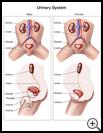
Urethritis (Caused by Soap) in Young Girls
What is urethritis?
Urethritis is when the urethra becomes irritated or infected. The urethra is the tube that connects the bladder to the vulva area. It carries the urine out of the bladder. The main symptom is burning or discomfort when passing urine. The vulva (outer part of the vagina) is also usually irritated. (vulvitis). The main symptom of soap vulvitis is itching of the vulva. This problem only occurs in young girls, long before puberty.
What is the cause?
Most urethritis and vulvitis in young girls is due to a soap irritation of the vulva. The usual irritants are bubble bath, shampoo, or soap left on the genital area. Occasionally, it is due to poor hygiene (such as wiping back to front). Before puberty, the lining of the vulva and urethra is very thin and sensitive to any soaps. If the urethritis spreads to the bladder, a bladder infection can occur (cystitis). This will cause worse symptoms such as more pain with passing urine, frequent urination and wetting. In addition, the urine will become cloudy and have a bad odor. If the vagina becomes infected, a vaginal discharge will occur.
How is it diagnosed?
Any child with painful urination needs a urine sample checked in a lab. This is to rule out a bladder infection. Soap urethritis is diagnosed by having symptoms of pain or mild discomfort when passing urine plus a normal urine exam.
How can I take care of my child?
- Pain relief
Give your child acetaminophen (Tylenol) or ibuprofen (Advil) for the painful urination
- Baking soda, warm water soaks
Have your daughter soak her bottom in a basin or bathtub of warm water for 10 minutes. Add 4 tablespoons of baking soda per tub of warm water. (Note: Baking soda is better than vinegar soaks for the younger age group). Be sure she spreads her legs and allows the water to cleanse the genital area. No soap should be used. Repeat this twice a day for the next 2 days. This will remove any soap, concentrated urine, or other irritants from the genital area and promote healing. After the symptoms go away, cleanse the genital area once a day with warm water.
- Hydrocortisone cream
Apply a tiny amount of 1% hydrocortisone cream (a nonprescription item) to the genital area twice a day after the soaks. Do this for 2 days, then stop using it.
- Drink enough fluids
Encourage her to drink enough fluids to keep the urine light-colored. Concentrated urine can be an irritant.
How long does it last?
The discomfort goes away after 1 to 2 days of proper treatment.
How can I prevent recurrences?
- Only cleanse the genital area with warm water (soap is not needed). If necessary, use baby oil to remove any dried secretions from between the labia that don't come off with water.
- Don't use bubble bath before puberty because it is very irritating. Don't put any other soaps or shampoo into the bath water. Don't let a bar of soap float around in the bathtub. If you are going to shampoo your child's hair, do this at the end of the bath or only during showers.
- Keep the bath time less than 10 minutes. Have your child try to urinate immediately after baths.
- Wear cotton underpants. Underpants made of synthetic fibers (polyester or nylon) don't allow the skin to "breathe." Discourage wearing underpants during the night so the genital area has a chance to "air out."
- Teach your daughter to wipe herself correctly from front to back, especially after a stool.
When should I call my child's healthcare provider?
Call during office hours if:
- A urine sample hasn’t been checked for infection
- The pain and itching is not gone after 48 hours of treatment.
- Passing urine becomes more painful.
- Vaginal discharge or bleeding occurs.
- You have other concerns or questions.
Last modified: 2014-06-10
Last reviewed: 2017-06-05

